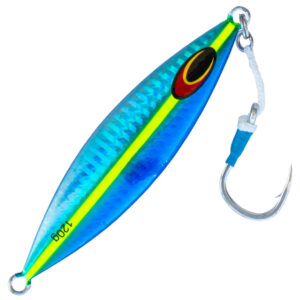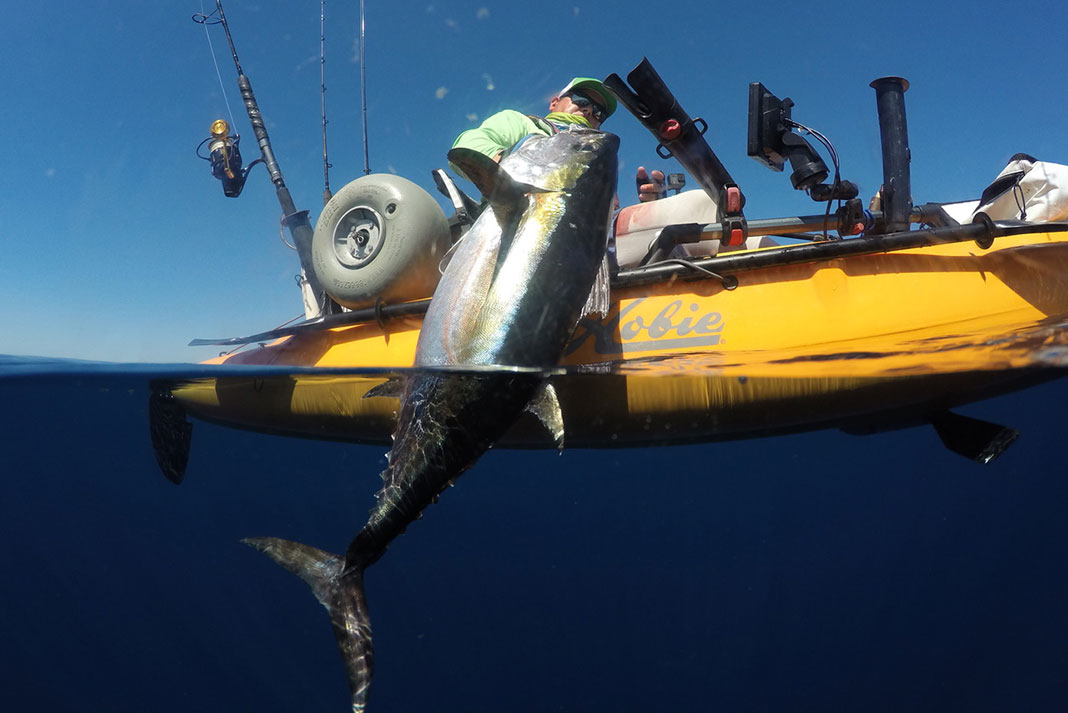Products You May Like
The ocean is a big place, finding fish requires a lot of searching. When I’m looking for tuna, wahoo, king mackerel and bottom fish off the South Florida coast, I pedal my kayak for miles and watch my fish finder for hours. As soon as I mark fish, I drop a vertical jig overboard and let it descend to the bottom. A few cranks of the reel handle and a couple wild rod-tip jerks are usually answered with a heavy strike and line quickly leaving the reel.
Vertical jigging is an extremely effective way to target almost any offshore species. The long, slender metal lures fall fast and dart like an injured squid or baitfish. If you want to catch fish offshore, you need to master speed jigging and slow-pitch jigging.
Picking The Best Jig for Pelagic Fish

Choose Your Speed
Speed jigs are long and narrow. They are designed to move fast with an erratic action. If the fish are spread out or I’m working an area in search of bites, I use a speed jig to quickly cover water and entice aggressive predators.
Slow-pitch jigs are wide and flat. I use a slow-pitch jig when the fish mark is concentrated or I’m trying to entice finicky fish. A slow pitch jig works great for fish on the bottom or hanging around structure. The jig stays in the target depth longer to give curious fish a good look.
Weight Watcher
The first step is to match the jig weight to the conditions. I use the same weight for a slow-pitch jig or vertical jig.
For example, if I am fishing in 200 feet of water with a three-knot current, I will go with a 200 or 250 gram jig. When the current is two knots or less, I drop to a 100 or 150 gram jig.
I want to use the lightest jig possible for the conditions. This makes it easier to work the jig and harder for the fish to throw the hook.
My favorite high-speed jig is a pink Nomad Tackle Streaker. For slow pitch, I like a Nomad Gypsy jig in blue or pink. These jigs are tough with strong components and durable finish. I don’t have to change hooks or terminal tackle to beef up a Nomad jig. The jigging action is proven to be a favorite for the fish, too.

Rod and Reel
My go-to rod for speed jigging is a six-foot Nomad Tackle jigging model rated for 30- to 50-pound line. For a fast retrieve, a shorter rod is easier to pump. A stout backbone quickly reacts to the jerks and drops of the rod tip.
My slow pitch rod is a Nomad Tackle six-foot, two-inch, 20- to 50-pound model. This rod is slower with a softer action to let the slow-pitch jig jump and flutter.
For both applications, I use a Penn 5500 Slammer filled with 50-pound braided line ending in six feet of 40-pound fluorocarbon leader. I use an FG knot to attach the leader to the braid.
Take a Position
I usually work a vertical jig while I’m drifting live baits. If I see bait on the surface, I drop a vertical jig below it. When my fish finder indicates fish under the kayak, I drop a jig below the depth of the fish mark. For example, when the fish mark is at 150 feet, I drop the jig 175 feet then work it up 50 feet and drop it again.
I pay close attention to the current. Offshore currents run up to five knots. If the lure streaks away from the kayak, it won’t hit bottom. With a lot of line out, the lure is less effective and it is harder to feel a bite or set the hook. The technique is called vertical jigging for a reason. For the lure to work properly, the jig needs to be directly below the kayak.
To keep the lure directly below the kayak, point the bow into the current. Then, cast the lure a few yards ahead of the bow.
As the lure drops, let the line run freely off the reel without overrunning or going slack. Keep the rod tip low and pointed towards the line to allow the lure to drop without any resistance.
Work It, Baby!
Once my jig hits the bottom, it’s time for action. To speed jig, I bounce the rod tip and turn the reel handle fast with a regular cadence all the way to the kayak.
To slow jig, I quickly lift the rod tip as high as possible, then slowly drop the tip to let the jig flutter down. I work the jig a few cranks off the bottom then drop again.
Working a speed jig in a kayak requires a specific body position to quickly turn the reel handle and jerk the rod. I lift my right knee and place my right elbow in the side of the knee. The rod butt is under my right armpit with my right hand around the foregrip. This position spreads out the power so I’m not relying only on my bicep to work the rod.
When I lift the rod tip, the reel handle goes down. As I lower the rod tip, the reel handle comes up. Repeating this action quickly and smoothly, the speed jig shoots towards the surface.
When a fish hits, it’s important to keep slack out of the line. If the fish charges the surface, reel fast to keep up. The biggest mistake when pumping the rod is dropping the tip too quickly. The slightest slack in the line, allows the fish to use the weight of the jig to pull the hook out of its mouth. Success depends on constant, maximum pressure.
When the fish gets close to the kayak, the jig offers a handy handle to grab and pull the fish on board.
Vertical jigging is an exciting way to make deep predators bite. When live baits aren’t getting action and I mark fish deep below the boat, I know I can get a bite with a slow-pitch or high-speed metal jig. The light, sturdy rods, braided line and streamlined jig allow anglers to go deep for big fish. If you’re heading offshore, be sure to have a vertical jigging rod in your arsenal.
Sucker for a slow pitch. | Feature photo: Eric McDonald

 This article was first published in the Summer 2022 issue of Kayak Angler Magazine.
This article was first published in the Summer 2022 issue of Kayak Angler Magazine.